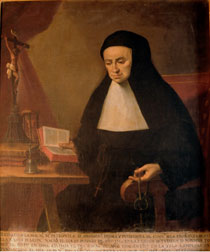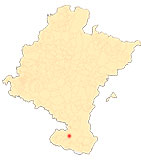The Church of the Company of Mary (Tudela)
By Ricardo Fernández Gracia
Chronology and artistic promotion of the temple
After half a century of presence in Tudela, the nuns were able to see an old project fulfilled, which was none other than to have their own church in accordance with the needs of their high school. The construction work lasted approximately ten years. Its beginnings can be traced back to a document dated 1731. It is a power of attorney of the nuns to request permission from the Patriarch of the Indies to collect money in the Indies in order to obtain the necessary funds. The proxies were a canon of the cathedral of Seville and Father Gaspar Rodero, a Jesuit.
The construction process coincided with the presence in positions of responsibility in the community of three religious of singular relevance. We are referring to Mothers María Ignacia de Gante, María Petronila de Aperregui, Francisca Croy and Incolaza Colmenares. The first of them died in 1740, when she was only twenty-three years old, in plenary session of the Executive Council during the construction process of the church. Petronila de Aperregui (1710-1790) belonged to the most florid of the nobility of Tudela, her family owned the board of trustees of the Chapel of the Virgen de los Remedios, in San Nicolás and was a founder in San Fernando where she died and left a great literary bequest . Mother Croy was the daughter of the former viceroy of Navarre, Prince Chimaz (†1686). She entered in 1703 and died in 1767, after having exercised different offices and that of prioress between 1725 and 1734 and from 1737. In 1744 she went to the foundation of Zaragoza and after ten years returned to Tudela. Mother Colmenares was from Pamplona and sister of the poet and oidor Don José Ignacio. She was the great architect of the increase of vocations and went to the foundation of Compostela, after having been one of the forgers of the training of the foundress of Mexico, Mother Azlor.
As for financing, it should not be forgotten that King Philip V granted, in 1719, an annual pension of 1,000 ducats on the income of the Archbishopric of Toledo, which was collected for more than a century and that in 1731 alms began to arrive from New Spain, thanks to the application of the nuns and the timely permission of the Patriarch of the Indies, giving power to a canon of Seville and to Father Gaspar Rodero, Jesuit and procurator of the causes and business in the Indies of the Society. In 1732 the works began and on April 6, 1744 it was inaugurated with great festivities. The completion of the second phase and final, with choirs (high and low), facade and pantheon was executed by José Marzal between 1756 and 1761.
-
PUIG Y ARBELOA, M. C., review histórica de la fundación del convento de religiosas de la Compañía de María y teaching de Tudela, Madrid, Imprenta a position de D. R. P. Infante, 1876.
-
FOZ Y FOZ, M. P., La revolución pedagógica en Nueva España 1754-1820 (María Ignacia de Azlor y Echeverz y los colegios de la teaching), Madrid, high school Gonzalo Fernández de Oviedo, 1981.
-
ECHEVERRÍA GOÑI, P., and FERNÁNDEZ GRACIA, R., "La arquitectura religiosa de los siglos XVI al XVIII en Navarra", Ibaiak eta Haranak. guide del Patrimonio artístico y paisajístico. Navarra, vol. VIII, San Sebastián, Etor, 1991.
-
AZANZA LÓPEZ, J. J., Arquitectura Religiosa Barroca en Navarra, Pamplona, Government of Navarre, 1996.
-
FERNÁNDEZ GRACIA, R., The Baroque altarpiece in Navarre. Pamplona, Government of Navarre, 2003.
-
CARRASCO NAVARRO, C., Los palacios barrocos de Tudela. Arquitectura y Nobleza, Tudela, Castel Ruiz- M. I. Ayuntamiento de Tudela, 2014.












